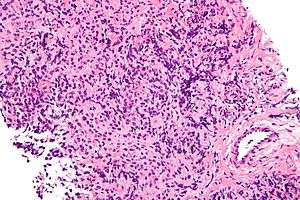Large-cell lymphoma
| Large-cell lymphoma | |
|---|---|
 | |
| Micrograph of a primary mediastinal large B-cell lymphoma, a type of large-cell lymphoma. H&E stain. | |
| Classification and external resources | |
| ICD-9-CM | 200.7 |
| MeSH | D016403 |
One classification system for lymphomas divides the diseases according to the size of the white blood cells that has turned cancerous. The large-cell lymphomas have large cells. A large cell, in this context, has a diameter of 17 to 20 µm.[1] Other groups of lymphomas in this system are the small-cell lymphomas and mixed-cell lymphomas.
Types
B cell
Diffuse large B-cell lymphoma is the most common of the large-cell lymphomas. MeSH now classifies the phrase "large-cell lymphoma" under "Diffuse large B cell lymphoma".[2]
Many other B-cell lymphomas feature large cells:
- Angiocentric lymphoma
- Burkitt’s lymphoma
- Follicular large-cell lymphoma
- Immunoblastic lymphoma
- Intravascular large-cell lymphoma
- Primary mediastinal B-cell lymphoma
- T-cell–rich B-cell lymphoma
- Primary splenic lymphoma (rare)
- Primary central nervous system lymphomas, which are often diffuse large-B-cell lymphomas
Activated B-Cell Diffuse Large B-Cell Lymphoma, or ABC-DLBCL, is believed to be caused by aberrant activation of a critical intracellular pathway. This intracellular signaling pathway involved in B-cell activation and proliferation stays constantly activated, driving lymphocytes to proliferate continuously. The inhibition of this pathway can be induced by a drug known as NEMO Binding Domain, or NBD, a peptide causing increased cell death of malignant lymphocytes.
T cell
Less commonly, a large-cell lymphoma may feature T cells. Anaplastic large-cell lymphoma is an example of a large-cell lymphoma that involves T cells. Of the large-cell T-cell lymphomas, it has the best prognosis.
References
- ↑ Turgeon, Mary Louise (2005). Clinical hematology: theory and procedures. Hagerstown, MD: Lippincott Williams & Wilkins. p. 221. ISBN 0-7817-5007-5.
- ↑ Large cell lymphoma at the US National Library of Medicine Medical Subject Headings (MeSH)